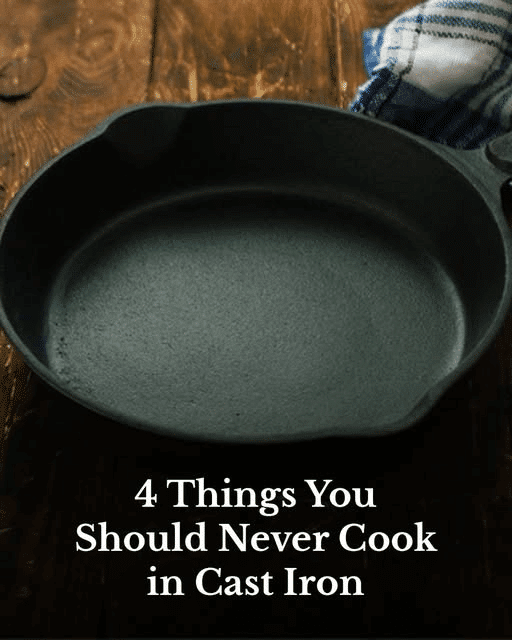Cast iron skillets are legendary in the kitchen. Known for their durability, even heat distribution, and versatility, they’re a favorite among home chefs and food bloggers alike. From one-pan dinners to indulgent skillet desserts, these pans are a go-to in many kitchens. However, even the best cast iron cookware has its limits. While they shine in many recipes, there are certain foods that don’t pair well with this kind of pan. Understanding what not to cook in cast iron can save your cookware—and your meals.
Whether you’re new to cast iron or a seasoned pro, avoiding these common cooking mistakes can extend the life of your pan and improve your food’s flavor. Let’s dive into the top four things you should never cook in a cast iron skillet.
1. Strong-Smelling Foods Can Linger in Your Skillet
When it comes to cooking foods like garlic, onions, peppers, pungent cheeses, and certain types of fish, cast iron isn’t always your friend. These ingredients can leave behind strong aromas that linger in the porous surface of the skillet. The result? Your next dish might carry unexpected flavor notes. A chocolate skillet brownie should not taste like garlic! While you can remove odors by baking your skillet at 400ºF for 10 minutes, it’s best to avoid cooking overly aromatic ingredients if you’re switching to delicate or sweet recipes soon after.
2. Eggs and Other Sticky Foods Are a Bad Match for New Cast Iron
Sticky foods like eggs, pancakes, or crepes are known for clinging to pans—especially when your cast iron hasn’t developed a deep seasoning yet. New skillets, even pre-seasoned ones, often don’t have the slick surface that prevents sticking. Until your pan builds up that perfect non-stick layer, consider using a traditional non-stick or ceramic pan for these delicate items. Trying to scrape scrambled eggs off your new cast iron can turn a quick breakfast into a frustrating cleanup job.
3. Delicate Fish Can Break Apart from Cast Iron’s High Heat
Cast iron holds heat exceptionally well, which is excellent for searing steaks or crisping chicken thighs. But when it comes to cooking tender fish like tilapia, trout, or sole, the intense heat can easily cause them to fall apart. These types of fish require more gentle cooking methods, making a non-stick or stainless steel pan a better choice. However, firmer fish such as salmon or swordfish can handle the heat just fine. In fact, cast iron salmon is a favorite recipe for achieving crispy skin and flaky meat.
4. Be Cautious with Acidic Ingredients Like Tomatoes and Citrus
There’s a long-standing debate among chefs and kitchen pros about whether acidic foods should be cooked in cast iron. Ingredients like tomatoes, lemon juice, vinegar, and wine may react with the metal, especially if the skillet isn’t well-seasoned. This can affect both the taste of the food and the integrity of your pan’s seasoning. Some believe the acid breaks down the seasoning and causes metallic flavors, while others think it’s exaggerated. If your pan does become discolored, a quick scrub with baking soda can help restore its surface. To be safe, limit prolonged simmering of acidic dishes in traditional cast iron unless you’re using an enamel-coated version.
A Quick Note About Enamel-Coated Cast Iron
If you’re using an enamel-coated cast iron pan—like popular Dutch ovens or high-end skillets—you don’t need to follow these restrictions. These pans are safe for acidic dishes, delicate foods, and even dairy-based sauces. Their smooth interior protects your ingredients and eliminates the concerns that come with raw cast iron.
Made a Mistake? No Problem—Here’s How to Restore Your Cast Iron
One of the best things about cast iron cookware is its resilience. If you accidentally cook something sticky or acidic, don’t panic. Cast iron can be restored with proper cleaning and re-seasoning. Use hot water and a brush to remove residue, dry the pan completely, and apply a thin layer of oil before baking it in the oven. This simple re-seasoning process can breathe new life into a neglected skillet.
Final Thoughts: Make the Most of Your Cast Iron Cookware
Knowing what not to cook in cast iron is just as important as knowing what to cook. With a little care, your cast iron pan can last a lifetime. Avoid smelly ingredients, sticky foods, delicate fish, and prolonged exposure to acids to keep your skillet performing at its best. Stick to searing, frying, roasting, and baking—and you’ll enjoy perfect results every time.
Looking to learn more about cookware safety, kitchen tips, and high-performance cooking gear? Bookmark our site for expert cooking hacks, home chef advice, and money-saving kitchen upgrades.
